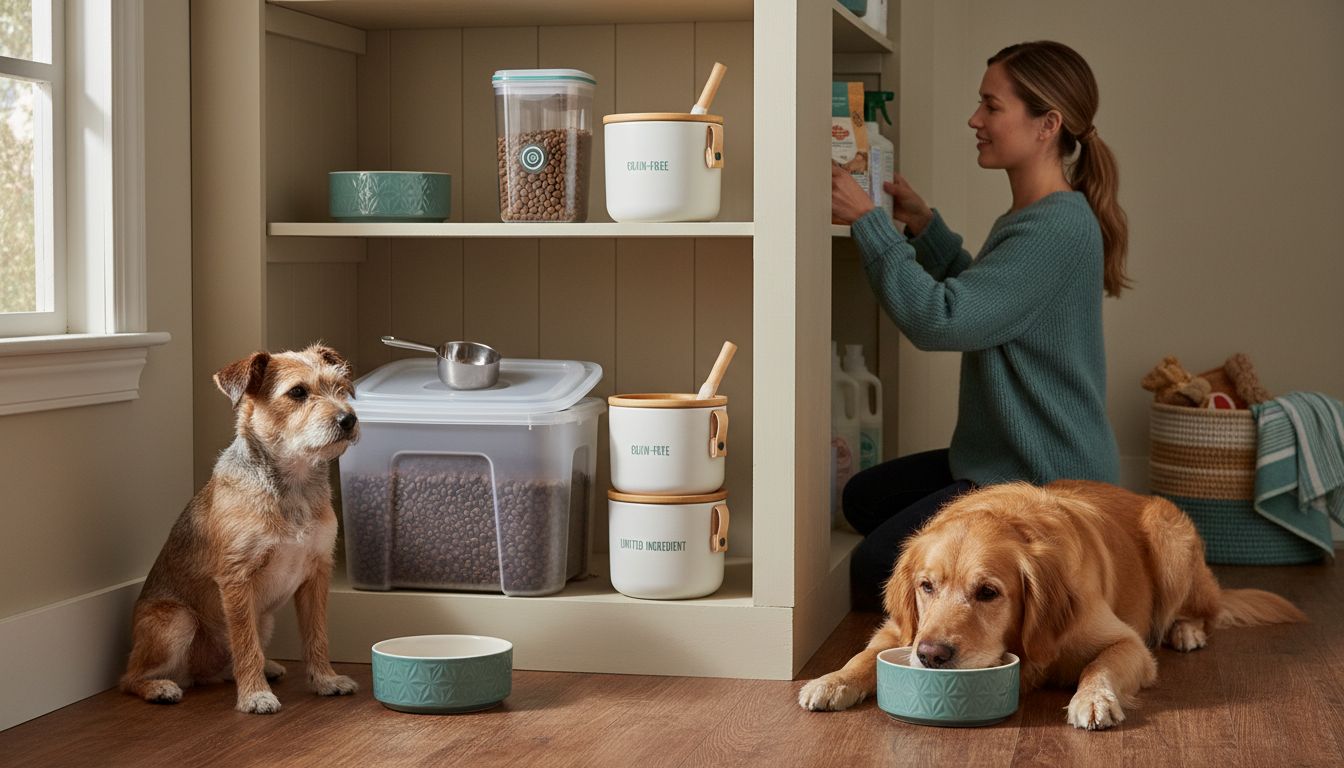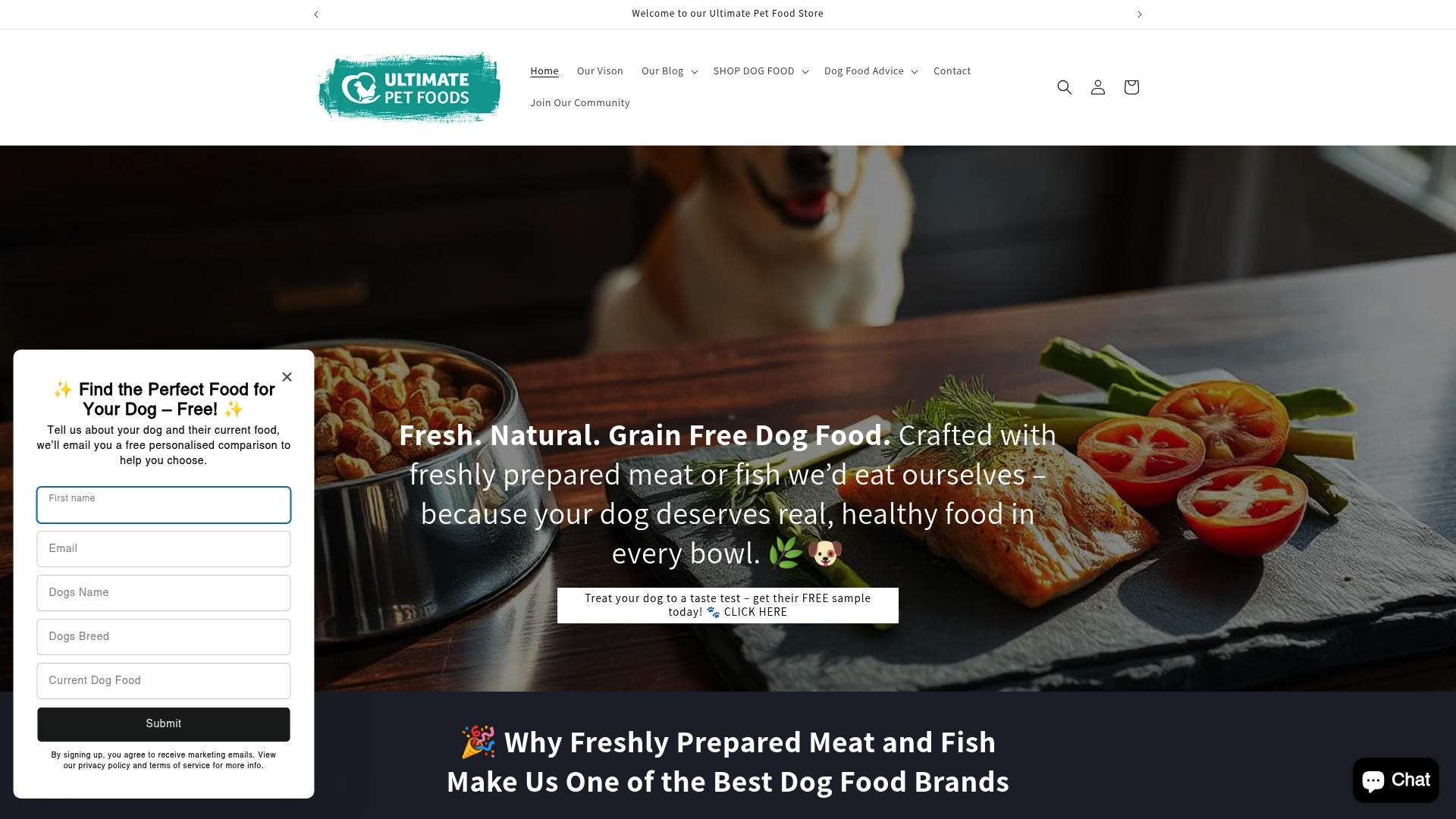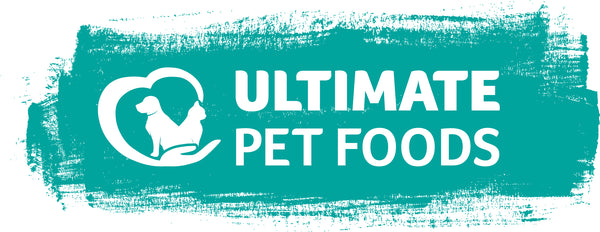Complete Guide to Dog Food Storage Containers

Share
Did you know that improper storage can strip up to 50 percent of vital nutrients from your dog’s food? Food exposed to air, moisture, or pests becomes less tasty and loses key health benefits. Protecting your dog’s meal is about more than avoiding stale kibble. The right container can keep every scoop fresh, flavorful, and safe so your pet thrives with every bite.
Table of Contents
- Dog Food Storage Containers Explained
- Types, Materials, And Size Options
- Key Features For Freshness And Safety
- Hygiene, Cleaning, And Storage Best Practices
- Common Mistakes When Storing Dog Food
Key Takeaways
| Point | Details |
|---|---|
| Airtight Sealing | Essential for preventing moisture and pest contamination, maintaining food quality. |
| Material Quality | Use BPA-free, non-toxic materials to ensure food safety and avoid chemical leaching. |
| Regular Cleaning | Clean storage containers every 4-6 weeks to maintain hygiene and prevent bacterial growth. |
| Avoid Common Mistakes | Do not store food in original packaging or damaged containers to prevent exposure to environmental threats. |
 |
|
Dog Food Storage Containers Explained
Keeping your dog’s food fresh, safe, and nutritionally intact requires more than just a basic container. According to Horse and Hound, dog food storage containers are specifically designed to protect pet food from critical environmental threats like moisture, humidity, and unwanted pests while maintaining its essential flavor and nutritional value.
The primary purpose of a high-quality dog food storage container extends beyond simple preservation. Husse highlights that these containers play a crucial role in maintaining the food’s sensory qualities - preserving its smell, crunchiness, and taste while preventing easy access by curious pets or potential contamination. This means selecting the right container isn’t just about storage, but about protecting your dog’s dietary investment.
When considering a dog food storage solution, several key features become paramount:
- Airtight Sealing: Prevents moisture and air from degrading food quality
- Material Durability: Resistant to cracking, breaking, or absorbing odors
- Size Flexibility: Accommodates different bag sizes and feeding frequencies
- Easy Cleaning: Smooth surfaces that can be thoroughly sanitized
Our freshly prepared dry kibble, gentle cooked at 82°C to lock in nutrients and using human-grade ingredients, deserves premium storage. By investing in the right container, you’re not just storing food - you’re preserving its nutritional integrity and ensuring every meal supports your dog’s health and happiness.
Learn more about maintaining your dog’s nutritional standards in our guide on storing dog food naturally.
Types, Materials, and Size Options
Horse and Hound reveals that dog food containers come in a diverse range of sizes and materials, typically spanning from compact 5L options to substantial 38L containers. These storage solutions are thoughtfully designed to accommodate different household needs, dog sizes, and feeding frequencies.
When it comes to materials, the primary focus is on safety and durability. Most high-quality containers are crafted from BPA-free, non-toxic plastic that ensures your dog’s food remains uncontaminated. Husse confirms that containers are available in various capacities like 20kg and 38L, designed specifically to keep pet food fresh and secure.
Key container types and features include:

Here’s a comparison of common dog food storage container types and their key features:
| Container Type | Main Features | Ideal For |
|---|---|---|
| Stackable | Space-saving Organised storage |
Multi-dog households |
| Rolling | Integrated wheels Easy mobility |
Large bags Quick movement |
| Built-in Scoop | Included scoop Portion control |
Accurate feeding Convenience |
| Vacuum-Sealed | Maximum freshness Airtight seal |
Long-term freshness High-value kibble |
- Stackable Containers: Perfect for multi-dog households or organized storage
- Rolling Containers: Feature integrated wheels for easy mobility
- Built-in Scoop Containers: Include measuring scoops for precise portioning
- Vacuum-Sealed Containers: Provide maximum freshness protection
Our freshly prepared dry kibble, gentle cooked at 82°C to lock in nutrients and using human-grade ingredients, requires premium storage solutions that match its quality. Choosing the right container isn’t just about size - it’s about preserving the nutritional integrity of every meal.
Learn more about maintaining your dog’s nutritional standards in our guide on storing dog food naturally.
Key Features for Freshness and Safety
When it comes to preserving your dog’s food quality, container features are paramount. Horse and Hound highlights critical characteristics that elevate a dog food container from basic storage to a sophisticated preservation system. Key features include airtight seals that meticulously protect against moisture and potential pest intrusion, coupled with full-top openings designed for effortless filling and cleaning.
Husse emphasizes that exceptional dog food containers are engineered to maintain the food’s essential sensory qualities - preserving its distinctive smell, satisfying crunchiness, and original taste. This preservation goes beyond simple storage, acting as a critical barrier against environmental degradation and potential contamination.
Critical safety and freshness features to consider include:
- Food-Grade Material: BPA-free, non-toxic plastics ensuring zero chemical leaching
- Tight-Sealing Mechanisms: Prevent air and moisture from compromising food quality
- UV Protection: Shields food from light degradation
- Temperature Resistance: Maintains food integrity across varying environmental conditions
Our freshly prepared dry kibble, gentle cooked at 82°C to lock in nutrients and using human-grade ingredients, demands nothing less than premium storage solutions. By investing in a container with these advanced features, you’re not just storing food - you’re safeguarding your dog’s nutritional wellness.
Discover more about maintaining optimal nutrition in our guide to understanding fresh dog food benefits.
Hygiene, Cleaning, and Storage Best Practices
Maintaining impeccable hygiene in your dog food storage system is crucial for preserving nutritional quality and preventing potential health risks. Conwy recommends using airtight containers specifically to reduce vermin risk and ensure food remains dry and in optimal condition.
Horse and Hound highlights the importance of easy cleaning, noting that many modern dog food containers are dishwasher-safe, which dramatically simplifies maintenance and ensures consistent hygiene. This feature is particularly valuable for pet owners seeking convenient yet thorough cleaning solutions.
Essential hygiene and storage best practices include:
- Regular Container Cleaning: Wash containers every 4-6 weeks
- Avoid Cross-Contamination: Use separate containers for different food types
- Temperature Control: Store in cool, dry areas away from direct sunlight
- Inspect for Damage: Check containers regularly for cracks or wear
- Use Clean Utensils: Always use dry, clean scoops when handling food
Our freshly prepared dry kibble, gentle cooked at 82°C to lock in nutrients and using human-grade ingredients, deserves meticulous storage practices. By implementing these comprehensive hygiene protocols, you’re not just storing food - you’re protecting your dog’s nutritional wellness.
Learn more about maintaining optimal nutrition in our guide to understanding fresh dog food benefits.
Common Mistakes When Storing Dog Food
Conwy warns that improper storage can significantly compromise your dog’s food safety and nutritional integrity. One of the most critical mistakes pet owners make is using non-airtight containers, which expose food to potential vermin contamination and moisture damage.
Horse and Hound emphasizes the severe consequences of inadequate food storage, highlighting how exposure to environmental factors can rapidly degrade food quality and nutritional value. These storage errors can transform your premium dog food into a potential health hazard.
Common dog food storage mistakes include:
- Leaving Food in Original Packaging: Increases risk of moisture and pest exposure
- Storing in Humid Environments: Promotes mould and bacterial growth
- Using Damaged Containers: Creates entry points for contaminants
- Inconsistent Cleaning: Allows residue buildup and potential bacterial contamination
- Ignoring Expiration Dates: Risks feeding spoiled or nutrient-depleted food
Our freshly prepared dry kibble, gentle cooked at 82°C to lock in nutrients and using human-grade ingredients, requires meticulous storage to maintain its exceptional quality. Understanding and avoiding these common mistakes is crucial for protecting your dog’s health and nutrition.
For deeper insights into maintaining your dog’s dietary wellness, explore our guide on dog food types and nutrition.
Protect Your Dog’s Food with Premium Storage and Nutrition
Storing your dog’s food correctly is vital to preserving its freshness, flavour and nutritional benefits. If you worry about moisture, pests or losing the quality of your dog’s meals, choosing the right container is just the first step. Pair that with feeding your dog fresh, grain-free foods crafted with care and human-grade ingredients for optimal health.

Explore our range of Dry Dog Food | Grain-Free & Science-Backed Kibble that deserves storage in premium containers to maintain its integrity. Visit Ultimate Pet Foods today to find tailored nutrition for your dog’s breed and lifestyle. Start protecting every meal from the inside out by choosing quality food and storing it the right way now.
Frequently Asked Questions
What are dog food storage containers used for?
Dog food storage containers are designed to keep pet food fresh and safe by protecting it from moisture, humidity, pests, and environmental factors that can degrade its quality and nutritional value.
What features should I look for in a dog food storage container?
Key features to look for include airtight sealing to prevent moisture and air exposure, durable and non-toxic materials, size flexibility to accommodate different bag sizes, and ease of cleaning.
How can I maintain hygiene when storing dog food?
To maintain hygiene, regularly clean your storage container every 4-6 weeks, use separate containers for different food types to avoid cross-contamination, store your food in a cool, dry area away from sunlight, and always use clean utensils when handling food.
What common mistakes should I avoid when storing dog food?
Common mistakes include leaving food in its original packaging, storing in humid environments, using damaged containers, inconsistent cleaning, and ignoring expiration dates, all of which can lead to compromised food safety and nutrition.





